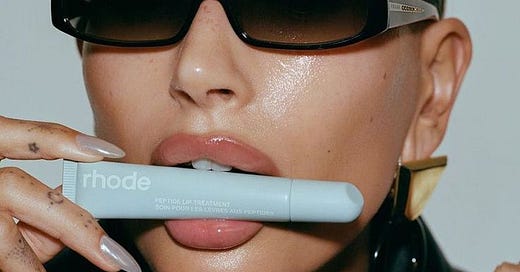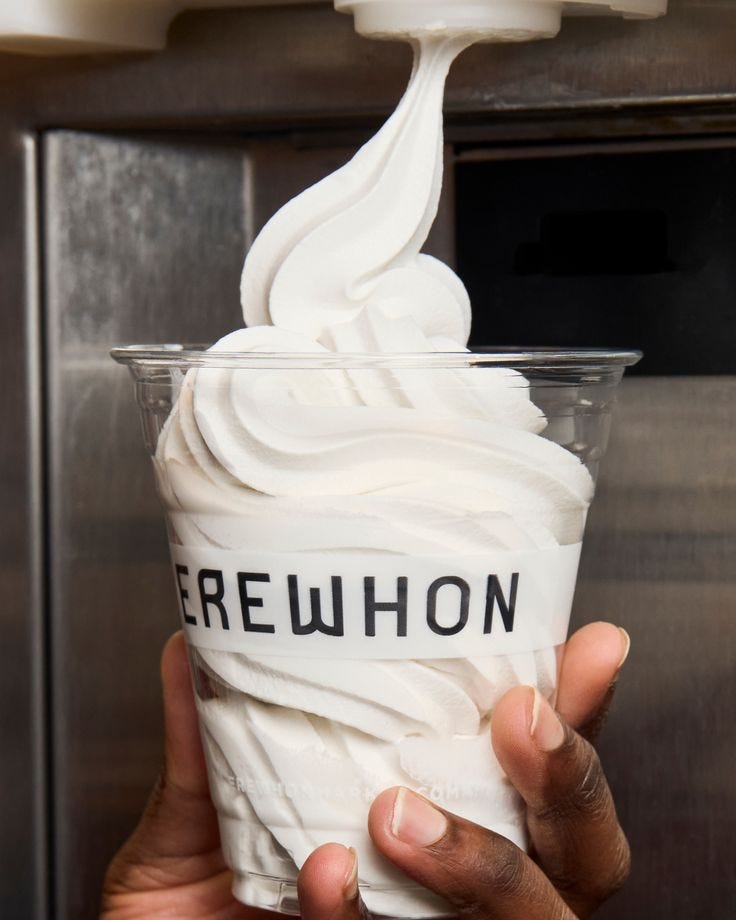The Cult Brand Formula: Decoded
How cult brands like Erewhon, Rhode and Alo Yoga turned belonging into big business — and what the next wave can learn.
Few grocery stores double as social hubs, but Erewhon isn’t most grocery stores. With curated shelves of raw nut butters, biodynamic kefirs and anti-inflammatory tonics, it has become a wellness mecca: part boutique, part café, a place to see and be seen. Stop by any of the Los Angeles locations, and you’re guaranteed to find preternaturally beautiful young people milling under bougainvillea-covered awnings with a $20 USD smoothie in hand or browsing the supplement aisle like it’s a concept store in SoHo. Those who don’t ‘get it’ could never fathom paying $19 USD for a single strawberry from Japan, but luckily enough for its founders, plenty of people do.
Once a niche health food co-op, Erewhon has morphed into a lifestyle monolith — a byword for a certain type of rarefied self-optimisation. It’s not just a grocery store, it’s a mise en scène for a curated, collagen-boosted life. A living, breathing billboard for $500 juicers and custom mushroom powders, and as The Cut once put it, an allure so strong, people will hold down three jobs just to afford to shop there.
Elsewhere, in yoga studios from Hollywood to Holland, eyeballs struggle to land on anything but the stitched “A” of Alo Yoga leggings as they move into their downward dogs. The successor to LuluLemon, Alo alchemised athleisure into something aspirational. Their playbook wasn’t product innovation, it was proximity. To the right bodies. In the right places. With enough high-saturation content and vitamin D to make spandex look spiritual.
Then there’s the original cult brand, Glossier, Emily Weiss’s pink-tinged beauty juggernaut which taught an entire generation of millennial women how to buy into a mood. As any woman of a certain age who visited NYC in the 2010s will recall, cueing around the block to stand in front of the “You Look Good” mirror or watching as your Boy Brow descended from a Willy Wonka-like conveyor belt, as if from the heavens, was the apex of earthly happiness. The iconic pink pouches wouldn’t pass the sustainability vibe check today, and the formulas were often average — but that was never the point. The point was identity. The products were just the access code. And as consumer tastes have evolved, so too has the beauty landscape: In 2022, Rhode stepped in as Hailey Bieber’s Gen-Z heir to the beauty throne Cloud Paint once ruled, with parasocial intimacy and a glazed aesthetic in place of millennial pink.
These brands aren’t just examples of hype well-executed. They’re case studies in modern brand devotion. And they all follow the same loose architecture: clarity, contradiction, community. Taste, tension, tribe.
So what’s the secret sauce? The winning formula? Make yourself comfy, nestle into your office chair or the butt groove of your couch, and let’s get down to demystifying it all…
Step 1: Defining A Cult Brand
Cult status has nothing to do with market share. It’s about meaning density.
The best cult brands are coded through language, design and behaviour in ways that make their audience feel not just seen, but selected. They don’t go wide. They go deep. This specificity creates something mass brands can’t manufacture: emotional exclusivity. You don’t stumble into a cult brand. You adopt it. You choose it, like you choose to be part of a certain scene or belief system. There’s a reason it’s called a cult brand — because like any good religion, it thrives on ritual, identity and a little bit of blind faith.
Cult brands don’t push. They pull. They build self-contained worlds with their own rituals, semiotics and values. Walk into an Erewhon and you know what’s expected of you. Same with a Glossier showroom. Same with the TikToks of a Rhode girl applying glazing milk with the unbothered finesse of someone who’s never had a breakout or a bad tax year. It’s not marketing. It’s myth-making.
Step 2: Deconstructing the formula: Taste + Tension + Tribe
Taste
True taste, not algorithmically-generated aesthetics, is as hard to fake as it is to define. Yet there is no such thing as a cult brand without a singular point-of-view. These brands make design and language decisions that repel the wrong people just as much as they attract the right ones. Look at Our Place: launched with a single pan, layered with cues that spoke directly to a subculture of domestic modernists. Madfe for people who revere tablescapes, who are convinced the aesthetics of a meal are as paramount as the taste of it, who approach hosting as if it were a dying artform. It’s a cooking brand, yes, but it’s also a thesis on third-wave adulthood. The aesthetic is soft, the strategy is sharp.
Tension
Every cult brand sits on a paradox. Hoka would make your geriatric parents’ heart sing as much as it would the next fashion girlie. Glossier introduced the concept of no-makeup makeup. Erewhon is wellness with the price tag of haute couture. Tension creates friction. Friction creates intrigue. Cult brands don’t explain themselves, they let the contradictions hum beneath the surface instead.
Tribe
There’s always an “us.” And there’s definitely a “not-us.” Cult brands define their audience so clearly. They don’t pretend to be for everyone. They give you symbols, be it a tote, a glazed-skin glow or a beige non-stick pan, that say: I get it. I belong here.
The result is a kind of commercial intimacy. A brand that doesn’t just understand your aesthetic but seems to share your worldview. And for everyone on the outside looking in, it becomes something to aspire to.
Step 3: Study The Icons Like A Religion
Erewhon
POV: Grocery store as luxury wellness theatre. Cult because it knows it’s absurd, and leans in. Product drops like streetwear. Smoothies like status symbols. Their entire business model is built on turning exclusivity into aspiration (and making it extremely Instagrammable).
Alo Yoga
POV: Activewear as aspirational lifestyle. Cult because it understands proximity. They don’t sell leggings, they sell the illusion of spiritual alignment. Yoga retreats, influencer-led classes, infrared saunas. It’s wellness as both practice and performance.
Glossier
POV: “You’re the beauty editor.” Cult because it offered identity, not just product. With packaging designed for shelfies and tone designed for DMs, Glossier blurred the lines between consumer and community.
HOKA ONE ONE
POV: Max cushioning, minimal hype. Cult because they made comfort cool. From orthotic-core to normcore to gorpcore, a running shoe that won the fashion crowd by not trying to.
The Row
POV: Quiet luxury, even quieter branding. Cult because it communicates by withholding. No phones at fashion week. No logos. No fuss. Just the unadulterated thrill of being part of a club of elite fashion girlies who can spot a $4,000 cashmere sweater a mile away.
Our Place
POV: Cookware as cultural belonging. Cult because it sold more than a pan: it sold an aesthetic, a dinner party fantasy, a lifestyle where hosting is identity. The Always Pan, completely inescapable for anyone living in 2025, isn’t a kitchen tool, it’s become a pastel-saturated starter pack for your "soft life" era.
Rhode
POV: Glazed skin, perfect branding. Cult because it feels personal. The tagline “one of everything, please” is grammatically incorrect — and completely intentional. It’s a wink. A tone. A text from Hailey herself. The brand works because it doesn’t just leverage celebrity; it feels like an authentic extension of her, glazed donut skin and all.
—
4. Building Cult Status (Without Forcing It)
You can’t manufacture a cult, but you can cultivate one (it’s all in the name ;). Here’s what the smart ones get right:
Clarity > Reach: Be loud about what you are. And what you’re not.
Don’t Be A Tryharr: Make it feel discoverable not aggressively over-marketed.
Own Your Codes: Design, tone, behaviour — everything should feel like a signature.
Protect the Core: Don’t overextend. Scale don’t wrong can kill mystique.
Say Something: Don’t aim for polite. Cults have an edge.
Reward the Obsessed: Easter eggs, layered meaning, slow reveals. Let your insiders feel in.
The most magnetic brands aren’t chasing relevance. They’re shaping identity.
Cult brands aren’t lightning in a bottle. They’re engineered through clarity, consistency and cultural tension. Never through volume, but rather through vision. Not with ads, but with atmosphere. The product is just the entry point, the real sale is who you become when you buy it. Where some brands are still optimising for virality, cult brands are playing a longer, stranger, smarter game. And as figures in the billions show, it’s paying off.
Subscribe to Public Opinion for more brand truth bombs, spicy takes, and the sharp, no-fluff insights founders actually use to win.
Public Opinion is where we talk. Smack Bang is where we do. Come see what we’ve been building →smackbang.co







Love taste + tension + tribe!
eeeeeeeek coming back to this one to study deeper + make notes! As a website designer working with those in the holistic and alternative fields selling services, I am challenged by the overwhelming lack of personality in the industry because of a need to be "inclusive" (*cough* people pleasing *cough*). Curious to explore this further with the aim to break spiritual people out of bland brand and into cult-like, iconic movements.